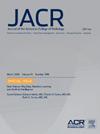Co-Development, Evaluation, and Dissemination of a Lung Cancer Screening Digital Outreach Intervention: A Multiphase Randomized Clinical Trial
IF 5.1
3区 医学
Q1 RADIOLOGY, NUCLEAR MEDICINE & MEDICAL IMAGING
引用次数: 0
Abstract
Purpose
Individuals from low–socioeconomic status (SES) communities experience worse lung cancer outcomes and multilevel barriers to lung cancer screening (LCS). Digital interventions may bridge LCS barriers. In this study, a three-phase design was used to rigorously develop, evaluate, and disseminate a digital outreach intervention to promote LCS among individuals from low-SES communities.
Methods
In phase 1, focus groups were conducted with primary care providers (n = 12), patient advocates (n = 8), and patients who had (n = 7) and had not undergone LCS (n = 8). Focus groups explored barriers and facilitators to LCS and guided the development of three LCS outreach videos, which differed by message source (radiologist, patient, or both). In phase 2, LCS-eligible individuals from a national sample (n = 315) were randomized 1:1:1 to evaluate the videos. Logistic regression analyses were conducted to quantify the association between outreach video and intent to talk to a provider about LCS. In phase 3, 636 participants due for LCS with Medicaid received the outreach video via patient portal or text or email. Reach of the intervention and 12-month LCS follow-up rates were measured.
Results
In phase 1, participants cited fear of lung cancer and confusion about LCS eligibility criteria. In phase 2, there were no significant differences in intent to speak to a provider about LCS by outreach video type. In phase 3, a significantly greater proportion of participants reached by the intervention had scheduled or completed LCS than those not reached (32.4% vs 23.2%, P = .041).
Conclusions
Participants who were reached by the digital outreach intervention codeveloped and disseminated to patients from low-SES communities were more likely to complete LCS.
肺癌筛查数字外展干预的共同开发、评估和传播:一项多阶段随机临床试验。
背景:来自低社会经济地位(SES)社区的个体肺癌预后较差,肺癌筛查(LCS)存在多层次障碍。数字干预可能会弥合LCS的障碍。本研究采用三阶段设计来严格开发、评估和传播数字外展干预,以促进低社会经济地位社区个人的LCS。方法:第一阶段:焦点小组(FG)与初级保健提供者(n=12)、患者辩护律师(n=8)和接受过LCS和未接受LCS的患者(n=7)进行了讨论。FG探讨了LCS的障碍和促进因素,并指导了3个LCS外展视频的开发,这些视频因信息来源(放射科医生、患者或两者)而异。第二阶段:从全国样本(N=315)中选取符合lcs条件的个体,按1:1:1的比例随机分配,对视频进行评估。逻辑回归分析量化了外展视频与与提供者谈论LCS的意图之间的关联。阶段3。636名即将接受医疗补助的LCS的参与者通过患者门户网站或文本/电子邮件收到了外展视频。测量干预的范围和12个月LCS随访率。结果:第一阶段:参与者表示对肺癌的恐惧和对LCS资格标准的困惑。阶段2:通过外展视频类型与提供者谈论LCS的意图没有显着差异。阶段3。参与干预计划/完成LCS的受试者比例显著高于未参与干预的受试者(32.4% vs. 23.2%, p= 0.041)。结论:与低社会经济地位社区的患者共同开发和传播数字外展干预的参与者更有可能完成LCS。
本文章由计算机程序翻译,如有差异,请以英文原文为准。
求助全文
约1分钟内获得全文
求助全文
来源期刊

Journal of the American College of Radiology
RADIOLOGY, NUCLEAR MEDICINE & MEDICAL IMAGING-
CiteScore
6.30
自引率
8.90%
发文量
312
审稿时长
34 days
期刊介绍:
The official journal of the American College of Radiology, JACR informs its readers of timely, pertinent, and important topics affecting the practice of diagnostic radiologists, interventional radiologists, medical physicists, and radiation oncologists. In so doing, JACR improves their practices and helps optimize their role in the health care system. By providing a forum for informative, well-written articles on health policy, clinical practice, practice management, data science, and education, JACR engages readers in a dialogue that ultimately benefits patient care.
 求助内容:
求助内容: 应助结果提醒方式:
应助结果提醒方式:


